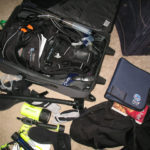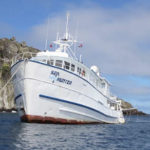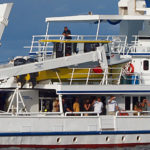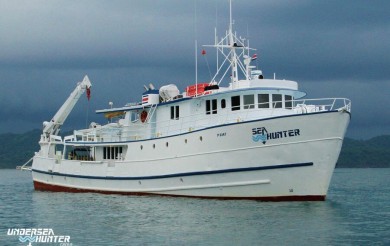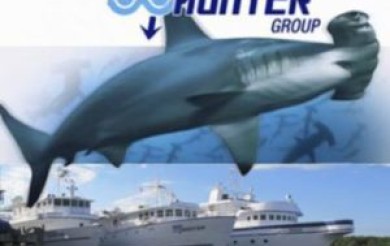The Great Whales of Cocos Island
Most of us think that whales are a large type of fish that roams around the world’s oceans. Yes, they are like travel bloggers who constantly wanders. But they are not fish, they are mammals. They do not have gills and they need to surface up in order to breathe in air. Just like human females, female whales have mammary glands, commonly called as the breast, which produces and gives off milk to their young during and after birthing period.
We often see them swimming gently in the surface especially for large species of whales. For a layman’s eye, they are mistaken for a huge floating log or a military submarine. Some of them has the ability to leap out of the water. They are capable of producing sounds underwater and their audio is further enhanced during mating period. In terms of underwater whale sounds, some species emit high frequency audio waves that can be heard from miles away. Some of them, especially for the smaller species, emits a clattering noise which humans perceive it as a form of a play.
Are Whalesharks Whales?
We decided to ask this question as we are bothered on the search results if you type the word “whale or whales” on the search bar and as a result from asking the same question from people around us. One of the answers that you will get are whalesharks. So again, we will ask the question: are whalesharks whales?
No. Whalesharks have gills and doesn’t need to surface up in the water to breathe in fresh air. They also don’t have mammary glands and does not emit any sort of sound. All these descriptions leads them to be classified as a fish and the only factor that can be comparable to them with whales is their size earning them the title “the biggest fish in the world.
Another difference that stands out between whalesharks and whales has something to do with their swimming pattern. If you have already interacted with them in the wild, you will notice that whalesharks swim sideways. They do this by stroking their caudal fin from left to right. On the other hand, whales swim with their tails called fluke using an upward and downward motion.
Species of Whales in Cocos Island
Short-finned Pilot Whale (Globicephala macrorhynchus)
Max. Length: 6.1 meters
Max. Weight: 3.6 tonnes
Depth Range: 0 – 1,000 meters (0 – 3,000 feet)
Frequency: Abundant in the World’s Tropical Waters
Compared to us, this small-sized whale is still bigger than any existing human on the planet where they can reach over six meters in length. They are often seen in groups that may consists of up to a hundred individuals.
While it is public knowledge that short-finned pilot whales are highly sociable and pose no threat to humans, you still have to be cautious when you interact and swim them. There are reports of snorkelers being dragged down underwater by short-finned pilot whales. While there are no fatalities recorded as the swimmers survived, scientist believed that this could be a case of mistaken identity where they become curious and playful with our presence in the open sea. This is especially true if we are wearing our wet suit where the usual black-color of the fabric matches with their own.
Video courtesy from Jakub Jedrzejewski
Humpback Whale (Megaptera novaeangliae)
Max. Length: 18.9 meters
Max. Weight: 35 tonnes
Depth Range: 0 – 4,000 meters (0 – 12,000 feet)
Frequency: Threatened; found in the World’s Major Oceans
Humpbacks has one the biggest appetite in the family of whales and interacting with this oceanic giant would have been scary if they have teeth. Fortunately enough, they don’t have. Instead, the have baleen which are hairy protrusions in their jaw that filter out food like krill and small fish. They are known to devour a school of fish in just a single opening of their mouth.
But chasing their prey requires some special technique. While most schooling fish forms a tightly packed group, humpback whales devours them all together by diving down deep and make a rapid ascent giving their prey the ultimate surprise of their life. This behavior is not only used when feeding. They also do this in their social behavior where they can jump almost completely out of the water called breaching. Well, we can say that they breach for fun but breaching could also be associated in getting rid off bacteria and parasites clinging to their body.
If you happen to be underwater during mating season, you will be surprised that you can actually hear their “love call”. This sound may come from thousands of miles away where and may last up to 24 hours until they can find a partner, or should I say, the love of their life. Another form of love call is the flapping of their highly elongated pectoral fin, which in human interpretation can mean “come here”.
Video courtesy from Wildcoast Adventures / The Globe Mail
Killer Whale (Orcinus orca)
Max. Length: 9.8 meters
Max. Weight: 10 tonnes
Depth Range: 0 – 2450 meters (0 – 8,085 feet)
Frequency: Abundant in the World’s Ocean but prefers cold temperate environment
Killer whales are one of the species of toothed whales that can easily be identified, that even children are familiar with them. In fact, they are the few species that we are very much familiar with their scientific name that we often call them “orca”. One of the reason for their popularity is their easy body identification where you will never forget their black colored body that is cover with a long white and curved stripe. Second reason for the popularity could be attributed to their intelligence and social behavior.
Killer whales are intelligent and sociable species. We presume that before you see them in Cocos island, you have already seen them not necessarily in the wild, but in theme parks. Yes, killer whales can be trained to do a specific task and exhibition where you will be surely amazed by their performance.
Video courtesy from Undersea Hunter
False Killer Whale (Pseudorca crassidens)
Max. Length: 6 meters
Max. Weight: 2 tonnes
Depth Range: 0 – 795 meters (0 – 2,600 feet)
Frequency: Abundant in the Indo-Pacific Ocean
Although belonging to a different group, false killer whales has a close resemblance to a true killer whale. Both of them are intelligent and highly sociable. They can also be trained in captivity, such as the ones you can see in theme parks, where they can perform tricks, stunts and exhibitions. In Cocos island, they are living in the wild, with no enclosures like the ones in a theme park, and often see them in groups called pods.
The obvious difference between false killer whale and a true killer whale is their size and body color. False killer whale is generally colored black with the absence of the long white curved stripe and their body size is generally smaller than a true killer whale.
Video courtesy from Sierra Goodman
And the BIGGEST, not just for whales, but for all ANIMALs . . .
Blue Whale (Balaenoptera musculus)
Max. Length: 33 meters
Max. Weight: 160 tonnes
Depth Range: 0 – 500 meters (0 – 1,500 feet)
Frequency: Abundant in the World’s Major Oceans
Measuring over 30 meters in length and weighing 160 tonnes, blue whales are the largest animal in the world. And not just this, they have numerous extreme records that no animal in the world can match. For example, in terms of body part they hold the record for the heaviest tongue where it is equivalent to the weight of an adult elephant.
If you are lucky in Cocos island and see the passing by of blue whales, you will really be amazed by their size where the length of your boat will be dwarfed by the enormous size of this gentle giant. Yes, they are gentle and not aggressive as compared to other species.
Swimming with them in the water will almost be impossible. Although you will be thinking that their swimming speed is low as you can see their slow-motion movement, but once you hit the water, you will realize that this slow-motion speed is fast enough that no swimming champion can chase them in a long distance race. Instead, what we suggest is that you go to the upper most deck of your liveaboard and have a panoramic view of them in their wild environment.
Video courtesy from Weird Underwater World – SZtv
Reference
Wikipedia: www.wikipedia.org
Sealife Base: www.sealifebase.org
Dive the World: www.dive-the-world.com
You also might like these:
Cocos Island Liveaboard Trips for 2019
Due to high demand of liveaboard trips to Cocos island, as early as this year, we are publishing the 2019 trips for you to choose your preferred schedule and prepare for the ultimate diving adventure of your life. Reserve your seat to Cocos Island as they are selling like hotcakes. Schedule of Liveaboard Trip to […]


















